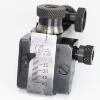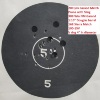Bogeyman68
Member
- Joined
- Feb 8, 2020
- Messages
- 32
Recently acquire a Remington Ranger 30/30 and started reloading for it. Have used hand loads and factory with same results. I suck with open sights. Ha. Not many adjustments can be made other than up down left and right correct? I have taken it as a challenge but at the moment I am losing. Any techniques I can try to improve?







